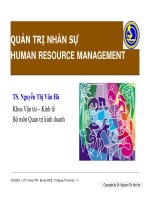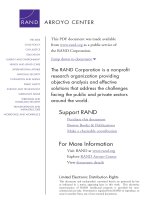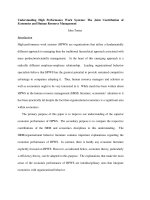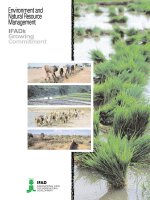HUman resource managemenr 2e s keiman chapter6
Bạn đang xem bản rút gọn của tài liệu. Xem và tải ngay bản đầy đủ của tài liệu tại đây (268.9 KB, 57 trang )
Chapter 6
Selecting Applicants
© 2010 Cengage Learning. Atomic Dog is a trademark used herein under license. All rights reserved.
Chapter Outline
•
6-1 Gaining Competitive Advantage
•
6-2 HRM Issues and Practices
•
6-3 The Manager’s Guide
© 2010 Cengage Learning. Atomic Dog is a trademark used herein under license. All rights reserved.
6-1a Opening Case: Gaining Competitive
Advantage at Southwest Airlines (SWA)
•
Problem: Selecting the best employees from
thousands of applicants.
•
Solution: Implementing targeted selection.
•
How the use of targeted selection enhanced
competitive advantage
SWA has been quite successful in achieving a
competitive advantage, due, in part, to its selection
practices.
© 2010 Cengage Learning. Atomic Dog is a trademark used herein under license. All rights reserved.
6-1b Linking Selection Practices to
Competitive Advantage
•
The effectiveness of a firm’s selection practices can
impact an organization’s competitive advantage in a
number of ways:
Improving productivity.
Achieving legal compliance.
Reducing training costs.
© 2010 Cengage Learning. Atomic Dog is a trademark used herein under license. All rights reserved.
6-2a Technical Standards for Selection
Practices
•
Validity, the technical term for effectiveness, refers to
the appropriateness, meaningfulness, and
usefulness of selection inferences.
•
The closer the actual job performances match the
expected performances, the greater the validity of the
selection process.
•
Manager must have a clear notion of the needed job
qualifications, and must use selection methods that
reliably and accurately measure these qualifications.
© 2010 Cengage Learning. Atomic Dog is a trademark used herein under license. All rights reserved.
6-2a Technical Standards for Selection
Practices (cont.)
•
Determining job qualifications
Job qualifications refer to the personal qualities an
employer seeks when filling a position.
Some qualifications, such as technical KSAs and
nontechnical skills are job-specific; other qualifications
are universal.
By basing qualifications on job analysis information, a
company ensures that the qualities being assessed
are important for the job.
Job analyses are also needed for legal reasons.
© 2010 Cengage Learning. Atomic Dog is a trademark used herein under license. All rights reserved.
6-2a Technical Standards for Selection
Practices (cont.)
•
Choosing selection methods
The choice of selection methods should reliably and
accurately measure the needed qualifications.
Reliability is the degree of self-consistency among the
scores earned by an individual.
Reliable evaluations are consistent across both people
and time.
© 2010 Cengage Learning. Atomic Dog is a trademark used herein under license. All rights reserved.
© 2010 Cengage Learning. Atomic Dog is a trademark used herein under license. All rights reserved.
6-2a Technical Standards for Selection
Practices (cont.)
•
The firm’s assessments should accurately measure
the needed worker requirements.
•
A particularly effective approach or model to follow
when making this decision is known as the behavior
consistency model.
•
The model specifies that the best predictor of future
job behavior is past behavior performed under similar
circumstances.
© 2010 Cengage Learning. Atomic Dog is a trademark used herein under license. All rights reserved.
6-2a Technical Standards for Selection
Practices (cont.)
•
To implement the behavior consistency model,
employers should follow this process:
Thoroughly assess each applicant’s previous work
experience to determine if the candidate has exhibited
relevant behaviors in the past.
If such behaviors are found, the manager should
evaluate the applicant’s past success on each
behavior based on carefully developed rating scales.
If such behaviors are not found, estimate the future
likelihood of these behaviors by administering various
types of assessments.
© 2010 Cengage Learning. Atomic Dog is a trademark used herein under license. All rights reserved.
6-2a Technical Standards for Selection
Practices (cont.)
•
Assessing and documenting validity
Content-oriented strategy: Demonstrate that it followed
“proper” procedures in the development and use of its
selection devices.
Criterion-related strategy: Provide statistical evidence
showing a relationship between applicant selection
scores and subsequent job performance levels.
Validity generalization strategy: Demonstrate that other
companies have already demonstrated the validity of
the selection instruments.
© 2010 Cengage Learning. Atomic Dog is a trademark used herein under license. All rights reserved.
6-2a Technical Standards for Selection
Practices (cont.)
•
Content-oriented strategy
Evidence would show that the selection devices were
properly designed and were accurate measures of the
needed worker requirements.
The employer must demonstrate that:
-
The selection devices were chosen on the basis of an
acceptable job analysis.
They measured a representative sample of the KSAs
identified.
© 2010 Cengage Learning. Atomic Dog is a trademark used herein under license. All rights reserved.
6-2a Technical Standards for Selection
Practices (cont.)
•
Criterion-related strategy
Attempts to demonstrate statistically that someone
who does well on a selection instrument is more likely
to be a good job performer than someone who does
poorly.
To gather criterion-related evidence, two pieces of
information are required : a predictor score and a
criterion score.
© 2010 Cengage Learning. Atomic Dog is a trademark used herein under license. All rights reserved.
6-2a Technical Standards for Selection
Practices (cont.)
•
Criterion-related strategy
Predictor scores: Represent how well the individual
fared during the selection process.
Criterion scores: Represent the job performance level
achieved by the individual, usually based on
supervisor evaluations.
Validity coefficient: An index of criterion-related validity
reflecting the correlation between selection and
criterion scores; should be at least r = .3.
© 2010 Cengage Learning. Atomic Dog is a trademark used herein under license. All rights reserved.
6-2a Technical Standards for Selection
Practices (cont.)
•
A criterion-related validation study may be conducted
in one of two ways:
Predictive validation study: Information is gathered on
actual job applicants.
Concurrent validation study:
-
Information is gathered on current employees.
More commonly used as they can be conducted more
quickly.
© 2010 Cengage Learning. Atomic Dog is a trademark used herein under license. All rights reserved.
6-2a Technical Standards for Selection
Practices (cont.)
•
Validity generalization strategy
Established by demonstrating that a selection device
has been consistently found to be valid in many other
similar settings.
Organization must present the following data:
-
Studies summarizing a selection measure’s validity for
similar jobs in other settings.
Similarity between jobs for which the validity evidence is
reported and the job in the new employment setting.
Similarity between the selection measures in the other
studies composing the validity evidence, and those
measures to be used in the new employment setting.
© 2010 Cengage Learning. Atomic Dog is a trademark used herein under license. All rights reserved.
6-2b Legal Constraints on Employee
Selection
•
Equal Employment Opportunity Commission (EEOC)
guidelines on employment discrimination
The Uniform Guidelines
National Origin Discrimination Guidelines
Sexual Harassment Guidelines
Pregnancy Discrimination Guidelines
Age Discrimination Guidelines
Religious Discrimination Guidelines
Disability Discrimination Guidelines
© 2010 Cengage Learning. Atomic Dog is a trademark used herein under license. All rights reserved.
6-2b Legal Constraints on Employee
Selection (cont.)
•
The Uniform Guidelines
Issued in 1978.
Apply to nearly all organizations employing 15 or more
employees.
Designed to assist organizations in understanding the
compliance requirements imposed by Title VII of the
Civil Rights Act, primarily with regard to disparate
impact claims.
© 2010 Cengage Learning. Atomic Dog is a trademark used herein under license. All rights reserved.
6-2b Legal Constraints on Employee
Selection (cont.)
•
National Origin Discrimination Guidelines
Individuals rejected for employment have just cause
for legal redress if their rejection was based on any of
the following factors:
-
Place of origin
Ancestor’s place of origin
Marriage to a person of a foreign origin
Membership in an association seeking to promote the
interests of a national origin group
© 2010 Cengage Learning. Atomic Dog is a trademark used herein under license. All rights reserved.
6-2b Legal Constraints on Employee
Selection (cont.)
•
Sexual Harassment Guidelines: The employer is
liable for unlawful sex discrimination if:
An employment opportunity is granted because of a
candidate’s submission to an employer’s request for
sexual favors.
An employment opportunity is withheld because of the
candidate’s refusal to grant such favors.
© 2010 Cengage Learning. Atomic Dog is a trademark used herein under license. All rights reserved.
6-2b Legal Constraints on Employee
Selection (cont.)
•
Pregnancy Discrimination Guidelines
A female applicant who is temporarily unable to
perform some job function due to her pregnancyrelated condition must be treated in the same manner
as any other applicant with a temporary disability.
The preferences of coworkers, clients, or customers
would not serve as a legitimate, nondiscriminatory
reason for rejecting such a candidate.
© 2010 Cengage Learning. Atomic Dog is a trademark used herein under license. All rights reserved.
6-2b Legal Constraints on Employee
Selection (cont.)
•
Age Discrimination Guidelines
Prohibits disparate treatment directed towards
applicants aged 40 and above.
If charged with age-based disparate treatment, a firm
must demonstrate that:
-
The hiring decision was not based on age, but on some
“reasonable factor other than age,” such as lack of skill.
Age is a BFOQ (bona fide occupational qualification) for
the position.
It is a business necessity.
© 2010 Cengage Learning. Atomic Dog is a trademark used herein under license. All rights reserved.
6-2b Legal Constraints on Employee
Selection (cont.)
•
Religious Discrimination Guidelines
Requires employers to accommodate a reasonable
request for religious accommodation, as long as the
accommodation does not pose an undue hardship on
their business operations.
When judging a claim of undue hardship, the courts
apply a standard called the “de minimis principle.”
The principle states that to be declared an undue
hardship, the cost of accommodation must be more
than minimal.
© 2010 Cengage Learning. Atomic Dog is a trademark used herein under license. All rights reserved.
6-2b Legal Constraints on Employee
Selection (cont.)
•
Disability Discrimination Guidelines
The act defines ‘‘disability’’ as a physical or mental
impairment that substantially limits one or more of an
individual’s major life activities.
A summary of the ADA guidelines give a detailed
account of what an organization may (or must) do and
what it may not do when it considers employing a
disabled applicant.
© 2010 Cengage Learning. Atomic Dog is a trademark used herein under license. All rights reserved.
6-2b Legal Constraints on Employee
Selection (cont.)
•
Constitutional constraints on selection – Fourth
Amendment to the U.S. Constitution
Pertains to an individual’s privacy rights.
Is the basis for workplace-related lawsuits dealing with
the use of certain physiological screening devices.
Imposes constraints on the type of information that
employers may lawfully collect about an applicant.
© 2010 Cengage Learning. Atomic Dog is a trademark used herein under license. All rights reserved.




![audio engineering 101 [electronic resource] a beginner's guide to music production](https://media.store123doc.com/images/document/14/y/ii/medium_iij1401381447.jpg)
![broken markets [electronic resource] a user's guide to the post-finance economy](https://media.store123doc.com/images/document/14/y/kz/medium_kzd1401381668.jpg)
![ios sdk programming [electronic resource] a beginner's guide](https://media.store123doc.com/images/document/14/y/ph/medium_phw1401472929.jpg)


